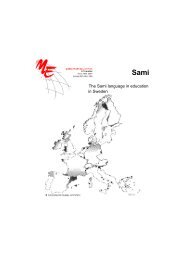Multilingual Early Language Transmission (MELT) - Mercator ...
Multilingual Early Language Transmission (MELT) - Mercator ...
Multilingual Early Language Transmission (MELT) - Mercator ...
Create successful ePaper yourself
Turn your PDF publications into a flip-book with our unique Google optimized e-Paper software.
speaking children; the idea is that these children will become functionally bilingual in<br />
Swedish and Finnish through the immersion programme. Most research in the field of<br />
immersion is carried out at Vaasan yliopisto/Vasa universitet (Vaasa university). 36 In 1980,<br />
the concept of immersion was first implemented in the Finnish-language school system in<br />
Vaasa, but the concept has spread especially to the area around the capital city Helsinki.<br />
There are private and municipality immersion pre-school provisions around the bilingual<br />
municipalities of Finland and more than 40 Swedish immersion day care centres in Finland,<br />
and the demand for immersion provisions as well for the Swedish care centres is growing.<br />
<strong>Language</strong> use in the pre-school provisions<br />
The pre-school provisions are categorised on the basis of their language of instruction in<br />
Swedish-language and Finnish-language institutions. The Swedish immersion pre-school<br />
teacher usually speaks fluently both Finnish and Swedish. This is typical for the urban<br />
bilingual areas in Finland, where Swedish-speaking families often live in a Finnish-speaking<br />
context.<br />
Some of the pre-school settings are bilingual with separate language groups within the<br />
institution, according to the language background of the children. You can also find some<br />
bilingual settings, with varying pedagogical and linguistically approaches.<br />
There also exist day care institutions with another language than Swedish or Finnish as the<br />
medium of instruction (for example, English, Russian).<br />
Collaboration between pre-school practitioners and parents<br />
If parents choose for a monolingual Swedish pre-school provision, they want their child to<br />
attend a Swedish day care group in order to give the child a chance to a good Swedish<br />
language competence when entering primary school. The parent participation depends on<br />
the policy of the pre-school institution.<br />
2.3.2 Institutions of the pre-school education<br />
According to the law every child has her/his subjective right to day care in her/his mother<br />
tongue. Day care must be offered to every child, if the parents so wish. Pre-school education<br />
starts for children from between the ages of 9 months and continue until they start<br />
compulsory primary school starts usually in August of the year when the child turns seven.<br />
Infants under age one are rarely enrolled in care centres because Finland offers generous<br />
parental leave support programs for parents in their child’s first year of life.<br />
In Finland, there are different kinds of day care institutions for children who have not yet<br />
started pre-school classes. Pre-school classes start at the age of 6 prior to primary school.<br />
In the Swedish community in Finland the institutions prior to primary school are:<br />
36 Buss, M. & Laurén, C. (1996) Immersion Requires a Wide Network. International connections provide new ideas for teaching. University of<br />
Vaasa. Translation by Sari Suistala. http://www.uwasa.fi/midcom-serveattachmentguid-29d06a4b29e85da1ac2963a34c5c693d/lang.pdf<br />
27



